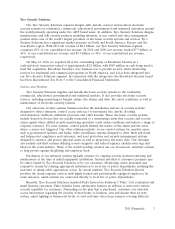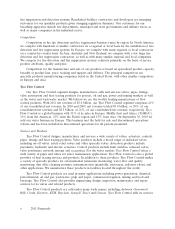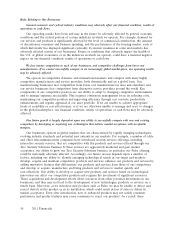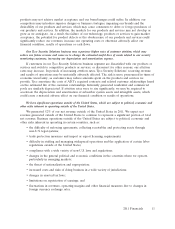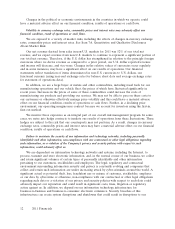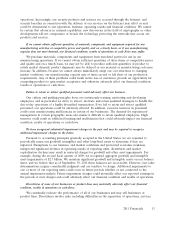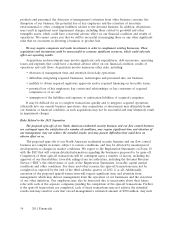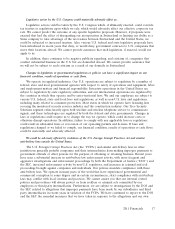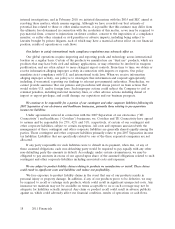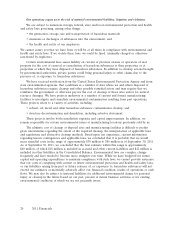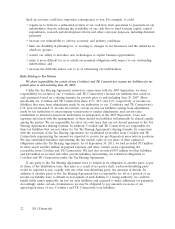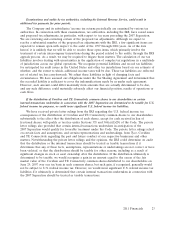ADT 2011 Annual Report Download - page 116
Download and view the complete annual report
Please find page 116 of the 2011 ADT annual report below. You can navigate through the pages in the report by either clicking on the pages listed below, or by using the keyword search tool below to find specific information within the annual report.operations. Increasingly, our security products and services are accessed through the Internet, and
security breaches in connection with the delivery of our services via the Internet may affect us and
could be detrimental to our reputation, business, operating results and financial condition. We cannot
be certain that advances in criminal capabilities, new discoveries in the field of cryptography or other
developments will not compromise or breach the technology protecting the networks that access our
products and services.
If we cannot obtain sufficient quantities of materials, components and equipment required for our
manufacturing activities at competitive prices and quality and on a timely basis, or if our manufacturing
capacity does not meet demand, our financial condition, results of operations or cash flows may suffer.
We purchase materials, components and equipment from unrelated parties for use in our
manufacturing operations. If we cannot obtain sufficient quantities of these items at competitive prices
and quality and on a timely basis, we may not be able to produce sufficient quantities of product to
satisfy market demand, product shipments may be delayed or our material or manufacturing costs may
increase. In addition, because we cannot always immediately adapt our cost structures to changing
market conditions, our manufacturing capacity may at times exceed or fall short of our production
requirements. Any of these problems could result in the loss of customers, provide an opportunity for
competing products to gain market acceptance and otherwise adversely affect our financial condition,
results of operations or cash flows.
Failure to retain or attract qualified personnel could adversely affect our business.
Our culture and guiding principles focus on continuously training, motivating and developing
employees, and in particular we strive to attract, motivate and retain qualified managers to handle the
day-to-day operations of a highly diversified organization. If we fail to retain and attract qualified
personnel, our operations could be adversely affected. In addition, excessive turnover in personnel
could cause manufacturing inefficiencies in certain of our businesses. The demand for experienced
management in certain geographic areas also makes it difficult to retain qualified employees. High
turnover could result in additional training and inefficiencies that could adversely impact our financial
condition, results of operations or cash flows.
We have recognized substantial impairment charges in the past and may be required to recognize
additional impairment charges in the future.
Pursuant to accounting principles generally accepted in the United States, we are required to
periodically assess our goodwill, intangibles and other long-lived assets to determine if they are
impaired. Disruptions to our business, end market conditions and protracted economic weakness,
unexpected significant declines in operating results of reporting units, divestitures and market
capitalization declines may result in material charges for goodwill and other asset impairments. For
example, during the second fiscal quarter of 2009, we recognized aggregate goodwill and intangible
asset impairments of $2.7 billion. We maintain significant goodwill and intangible assets on our balance
sheet, and we believe that as of September 30, 2011 these balances are recoverable. However, fair value
determinations require considerable judgment and are sensitive to change. Additional impairments to
one or more of our reporting units could occur in future periods whether or not connected to the
annual impairment analysis. Future impairment charges could materially affect our reported earnings in
the periods of such charges and could adversely affect our financial condition and results of operations.
Divestitures of some of our businesses or product lines may materially adversely affect our financial
condition, results of operations or cash flows.
We continually evaluate the performance of all of our businesses and may sell businesses or
product lines. Divestitures involve risks, including difficulties in the separation of operations, services,
2011 Financials 13


